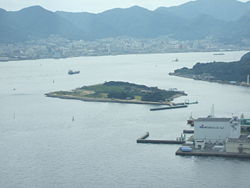There are many versions of his better known treatises and books in English, quasi biographies, television specials, and books of fiction about him that he has the image of being Japan’s ultimate swordsman. Like the proverbial sign pronouncing that “George Washington slept here,” it seems that everywhere that Musashi travelled lays claim to some direct transmission of seminal sword knowledge. This two- column two-inch article was written by an ex-Prime Minister of Japan named Hosokawa Morihiro. This is a famous clan name and indeed Hosokawa Morihiro is the 18th successor of the Hosokawa Han (fiefdom) It is home to the castle town of Kumamoto where 7 centuries of archives are housed intact in spite of fires, wars and changes in the social order. Today it is estimated that there are 80,000 historic documents and 7000 pieces of art which are being released one by one from these private collections so that they might be studied by museums and university historians. To provide some perspective this clan outlasted other great clans of Japanese history such as Oda Nobunaga (1 generation), the Toyotomi (2 generations), and the Tokugawa (15 generations).
For followers of Musashi in both fact and fiction there is a story of a duel to the death with a famous if as legend has it, unbalanced swordsman named Kojiro Sasaki. Conventional wisdom has it that Musashi nonchalantly fashioned an oar into a bokken, (wooden sword) arriving late to duel his nemesis Kojiro. This was billed as the fight of the Titans. Kojiro and his style of swordsmanship of Gan Ryu was bested with one masterful stroke and dispatched by Musashi. This took place on an island now called Ganryujima in honor of the defeated swordsman and the combat that took place there. The article entitled simply “Kojiro Lived” comes from the Hosokawa family treasure trove of documents written at the time of the duel. The Hosokawa themselves seemed to always practice soft power, avoiding conflict whenever possible. The peace afforded the clan the opportunity to keep meticulous records and this reader hopes with time will be released in full for all to savor. The article provides the following account: "It is in the 3rd generation called the Tadatoshi era that the famous duel between Musashiand Kojiro took place. The family record of the time, according to Numata Engen (a retainer at Kumamoto castle, whom also later helped Musashi to hide there) reports that Musashi struck Kojirounconscious. The many spectators who witnessed the duel included deshi (students) ofMusashi and as Kojiro came to, they struck him fatally. Although oral accounts might’ve differed at the time, this is the only known written record that exists on the subject. So much for the romantic notion of nobility and fair play! In point of fact this scenario repeated itself many times in Japanese martial history. As an interesting aside: In the famous tale of the 47 Samurai (Akou Roushi Ronin) a group of Ronin(masterless) warriors avenged the death of their lord whom was condemned to commitseppuku (ritual suicide) for an attack for a grievance with a treacherous court dilettante named Lord Oishi. After taking revenge to reclaim their lord's honor all turned themselves into the Tokugawa authorities and were placed under arrest. The group was too large to be housed at only one location. Seventeen of this number were held at the Hosokawa clan enclave to await sentencing and eventual seppuku. This story has had a major impact on Japanese folklore. Records showed that the Hosokawa treated these men as respected samurai whereas other clans treated other members of this revenge killing as criminals. One way that this was noted was in the number of dishes served with a meal. Hosokawa clan records state that the meals included 2 soups and 5 dishes which were by custom typically afforded to the highest ranked warriors. This was too “rich” for many of these men whom had become accustomed to a much poorer life style. They requested in writing that the meal standard be lowered to simpler diets.
0 Comments
Leave a Reply. |
AuthorRick Categories
All
Archives
January 2017
|
|
Po Box 232 Severna Park, MD. 21146
|
Copyright © 1996 - 2023


 RSS Feed
RSS Feed






